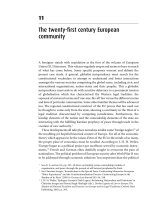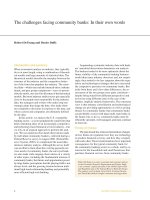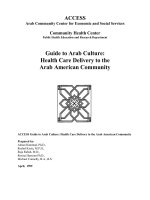The original European community
Bạn đang xem bản rút gọn của tài liệu. Xem và tải ngay bản đầy đủ của tài liệu tại đây (112.06 KB, 16 trang )
4
The original European community
In this great intermingling at the time of Europe’s birth, a salient feature, right
from the start, was the dialectic between unity and diversity, Christendom and
nations, which even today is still one of the fundamental characteristics of Europe.
Jacques Le Goff
1
As unjust as it might seem for a historical discussion of European society to dis-
pense with Greek and Roman antiquity, unjust we must be for present purposes.
(Reference will be made in later chapters, though, to reincarnations of Greek
philosophy and Roman law.) With the nightfall of the inaptly named ‘dark ages’
heralded by raiding Germanic tribes, the ‘high’ classical culture and Roman
Empire receded in the fifth and sixth centuries, in the face of fragmented,
indigenous diversity. This was tempered by the emerging universalistic, moral
and political tentacles of the Roman Catholic Church. It was that style of diver-
sity, after the fall of the Roman Empire, which was the original Europe. To the
extent there was then a medieval European union, membership depended not
upon the fulfilment of economic criteria required today, but the conversion of
people to Christianity.
2
Just as the challenges faced by the European Union (EU) today are endemic
of many of the challenges of globalisation and law, so may the original European
community assist our enquiry. Especially will this aid the formulation of a nor-
mative jurisprudence concerned to take questions of allegiance and authority
seriously. The diversity of Europe in the time preceding and including the foun-
dation of the Western legal tradition in the late eleventh century will be con-
sidered. Practical authority or sovereignty was extremely particular – there was
nothing like a state in the modern sense. Europe was made up of quasi-tribal
units, with the increasing legal formality of feudalism. Against that particular-
ity, papal authority was projected onto a rich social tapestry as a universalistic,
moral concern, becoming important for justifying authority at all social levels.
The limited political power of the first millennium papacy was buttressed by the
considerably greater political power of the ephemeral Carolingian Empire and
11
The Birth of Europe, trans. Janet Lloyd (Oxford: Blackwell Publishing, 2005), p. 19.
12
Le Goff, Europe, p. 43.
secular powers which would follow. All of this should help to sketch a picture
of the ‘true European Community’, the notion of which Philip Allott has con-
trasted to the inorganic, twentieth-century treaty version.
3
4.1 A rhetorical ‘holy Roman empire’
Chapter 3 proposed that a notion of ultimate reality and meaning or God
underlies a constitution. To make sense in a book concerning itself with the
Western legal tradition, reference must be made to God in association with
legal institutions. A way to do this is to associate the Holy Roman Empire with
the God of the Judeo-Christian tradition, and to reflect upon a vying if not
potentially substitute concept of that ultimate reality, culminating in a compet-
ing twentieth-century god-concept, Mammon. Perhaps too whimsically, this
movement can be thought about as a shift from the Holy Roman Empire to a
‘wholly Mammon empire’. The conclusion will not emerge in chapter 10 that
there is a wholly Mammon source of ultimate meaning legitimating Western law
today (although Mammon appears to dominate the contest so far as free trade
and human rights are concerned). To describe an extreme of a tendency,
however, the term ‘wholly Mammon empire’ can be illuminating, if the pun can
be excused. Implied in this shift is a functionally recurring authority (an ulti-
mate principle of ‘good’ upon which to justify law), in an ethically different
guise (that is, whereas material prosperity was not so important to the con-
ception of God at the beginning of the second millennium, it was extremely
important at the end of the second millennium and is so today).
Some flexibility is required in the use of the term ‘Holy Roman Empire’,
inherent in the title. Introduction of the name ‘Roman empire’, centuries after
the fall of its classical namesake, occurred by grant of the pope in the later part
of the tenth century when German kings sought to make Rome the capital of
the empire, in the quest for control over the kingdoms of Burgundy, Italy
and Germany. It became ‘holy’ in the later twelfth century when Frederick I
Barbarossa sought to establish the special nature of the empire, becoming for-
mally entitled the Holy Roman Empire in 1254.
4
England never recognised in
its own territorial realm the sovereignty of the emperor of the Holy Roman
Empire or a German king. Rhetorically, and to avoid confusion with the pri-
marily German association of the formal title, reference will be made descrip-
tively but not titularly to ‘a holy Roman empire’, when contrast is to be drawn
to a potential ‘wholly Mammon empire’, principally in part 4. This sense of ‘a
holy Roman empire’ is more akin to the Christian commonwealth than ‘the
80 A Holy Roman Empire
13
See Phillip Allott, ‘The European Community is Not the True European Community’ (1991)
100 Yale Law Journal 2485–500.
14
See Hendrik Spruyt, The Sovereign State and its Competitors: An Analysis of Systems Change
(Princeton: Princeton University Press, 1994), p. 235; Harold J. Berman, Law and Revolution:
The Formation of the Western Legal Tradition (Cambridge, MA: Harvard University Press,
1983), p. 89.
Holy Roman Empire’, as medieval rulers increasingly denied subordination to
the emperor. It is used in contrast to ‘a wholly Mammon empire’ as a pithy
attempt to capture the different ethics of functionally similar god-concepts
authorising law at the beginning and end of the second millennium. The holy
Roman empire evokes the contemporary notion of governance (not government
in the sense of one state-like government).
5
Moral allegiance to its universalist
norms was sought by the church through the authoritative normative text of the
Bible in an increasingly objective manner, in a relationship (at times stretched)
with local, particularistic political powers and ultimately the universalistic
6
Holy Roman Emperor himself. It represented a governmental alliance with high
claims to moral allegiance and political power within a relatively common nor-
mative history and vision for the future.
4.2 Tribalism
With the eruption of the Germanic invasions from the fifth century onwards,
the embrace of the classic Roman Empire gradually weakened.
7
The so-called
dark ages (about 476–800) were characterised by the raiding Gothic, Teutonic
and Viking tribes. Any functional equivalent of international law at that time
was difficult to conceive between tribes. Most Germanic tribes revered Valhalla,
the hall of the god Odin, who received the souls of warriors killed in battle.
8
The
other tribes had no less bellicose veins. When life is not revered, and death
for a cause praised within a culture, it becomes difficult to have law between
such cultures (a fact to which modern times still attest). Ultimate reality and
meaning in such societies inspires death and repulses a shared legal order.
A strong sense of normativity did, however, inhere within the Germanic
tribes and there were interclan meetings. Constitutional elements, for example
amongst the Visigoths, attempted to limit the autonomy of kings with respect
to the church, although in practice the king’s power was often unchecked.
9
The
Lombards availed their administration of Roman centralism and city and
diocesan structures. ‘Vulgar’ Roman law, a corrupted form of the original, sur-
vived,
10
although it is perhaps best regarded without deprecation as a point of
81 The original European community
15
On this distinction in today’s globalisation discourse, see ch. 12, section 12.3.2, pp. 291–2 below.
16
Frederick’s death on crusade in 1190 demonstrates the universalism of the Holy Roman
Empire inclusive of the papacy: Malcolm Barber, The Two Cities: Medieval Europe 1050–1320
(London: Routledge, 1992), p. 212.
17
On this gradual process, see Henry Chadwick, ‘Envoi: On Taking Leave of Antiquity’ in John
Boardman et al., The Oxford History of the Classical World (Oxford: Oxford University Press,
1986).
18
T. A. Walker, History of the Law of Nations (Cambridge: Cambridge University Press, 1899), p. 64.
19
O. F. Robinson, T. D. Fergus and W. M. Gordon, European Legal History (London:
Butterworths, 1994), [1.7.3].
10
See Franz Wieacker, ‘Foundations of European Legal Culture’ (1990) 38 American Journal of
Comparative Law 1–29, 9–10; Berman, Law and Revolution, p. 53; R. C. van Caenegem, An
Historical Introduction to Private Law, trans. D. E. L. Johnston (Cambridge: Cambridge
University Press, 1988), pp. 17–18.
departure from Roman law on the way to the arrival of the later medieval
European common law.
11
There was also a Christian influence, although super-
stition was rife in dispute resolution procedures such as trial by ordeal. An oral
legal tradition and some unsystematic compilations of laws did not stop blood
feuds, although there was a rationalisation of this process through emerging
lists of penalties.
12
The ultimate reality and meaning in these societies was
thought to reside in arbitrariness and fate.
13
On the Space-Time Matrix, there
was a high degree of interior, moral allegiance in these legal processes, without
exterior political power in the form of bureaucracy or decisions imposed by
unknown individuals. Generally, these societies were traditional and conserva-
tive, without a radical vision for the future.
As Sir Henry Maine wrote, this time and place in history can be characterised
by ‘tribe-sovereignty’. Germanic tribes were ‘masters’ over their occupied terri-
tories, although ‘they based no claim of right upon the fact of territorial pos-
session, and indeed attached no importance to it whatever’.
14
Frontiers were
more in the nature of meeting places than borders. Clashes at these meeting
places, as well as trade and general intermingling, were characteristic, including
the mixing of blood and ethnic regroupings.
15
Within this emerging, diverse
feudal society, two political powers did attempt to fill the vacuum left by the
Roman Empire. One would be relatively short-lived, and another the longest
surviving normative institution in the Western world: the Carolingian Empire
and the Roman Catholic Church, respectively.
4.3 Charlemagne’s short-lived political universalism
If Europe appeared when the ancient Roman Empire fell, Charlemagne’s empire
first gave Europe its form.
16
The Merovingians had ruled over the Franks occu-
pying transalpine Gaul and part of Germany as kings of the Franks, not kings of
France as a territory (which lacked dignity). The only alternative would have
been the ancient Roman imperial title of ‘emperor’ – a universalist claim to
rulership of the whole world.
17
The term ‘Europe’ was revived in, and survived
ephemerally with, the successor to the Merovingians, Charlemagne, who did
style himself after the Roman emperors. He ruled what is now much of western
Germany, France, northern Italy and part of northern Spain.
18
His aspirations
82 A Holy Roman Empire
11
Maurizio Lupoi, The Origins of the European Legal Order, trans. Adrian Belton (Cambridge:
Cambridge University Press, 2000), p. 38.
12
See van Caenegem, Private Law, pp. 18–19, 26.
13
See generally Berman, Law and Revolution, ch. 1.
14
Sir Henry Sumner Maine, Ancient Law: Its Connection with the Early History of Society and its
Relation to Modern Ideas [1861] (reprinted Dorset Press, 1986), p. 86.
15
Le Goff, Europe, pp. 4, 19.
16
Alessandro Barbero, Charlemagne: Father of a Continent, trans. Allan Cameron (Berkeley:
University of California Press, 2004), p. 3, quoting from Marc Bloch and Lucien Febvre.
17
Maine, Ancient Law, pp. 86–7. Territorial sovereignty, upon which modern sovereignty is
based, was to await the French Capetian dynasty (987–1328). See ch. 6 below.
18
See Norman F. Cantor (ed.), The Medieval Reader (New York: HarperPerennial, 1995), p. 97.
were universalist, as opposed to the previously fragmented concerns of tribal
chiefs, and wars were led against Lombards, Saxons, Gascons, Avars and Danes,
amongst others.
19
The universalist moral authority was reliant upon the papacy.
Either his father’s or his own hands crowned Charlemagne emperor, using an
unprecedented right assumed by pope Leo III on Christmas Day, 800. With the
pope’s immediate genuflection before Charlemagne in homage,
20
the theocratic
powers of Charlemagne as Vicar of Christ bound his legitimacy to that of Rome
and the futurist vision of the continuing Roman Empire as the final empire of
all time, believed to have been prophesied by Daniel in the Old Testament.
21
Yet
pagan Germanic rituals remained. Christianity was largely passive and used to
garb pagan superstitions.
22
This is analogous, perhaps, to the ‘glocalization’ we
have already seen of the Sapeurs of the Congo appropriating the Western, glob-
ally projected, image of the white coat of the medical profession to bolster the
prestige of the witch doctor.
23
Charlemagne’s ‘kingdom and empire were governed by an itinerant court
that journeyed incessantly from one domain to the next; by a number of
subordinate courts . . .; and by a network of perhaps 300 comitates or “coun-
ties” . . .’,
24
each controlled by a pair of envoys, one lay and one clerical.
25
A
comitatus was an assembly or general meeting of the population, where customs
were stated, sometimes reduced to writing and sometimes even changed, and
also where disputes might be settled. An imperial central court, the Aula Regis,
was able to influence more local courts. Semi-professional judges (scabini)
heard inquests, as sworn inquests sought to replace blood feuds and trial by
ordeal.
26
The Christian church spanned the continent and its diverse ethnic
identities and social ranks, providing ‘a supplementary structure of communi-
cation and leadership’, also seeing to some public needs such as welfare.
27
An international executive class arose, as did centralised currency. Capitularies,
or collected royal edicts (in today’s terms, ‘statutes, orders, directions and regula-
tions’),
28
encouraged uniform rules for church and state, although local customs
and leaders remained powerful. Previously unwritten customary laws were
recorded in writing.
29
Johan Galtung has noted the similarity between the EU
83 The original European community
19
See Einhard, ‘Life of Charlemagne’ in Cantor, Medieval Reader, pp. 97–103.
20
See Norman Davies, Europe: A History (London: Pimlico, 1997), pp. 301–2; Barbero,
Charlemagne, pp. 93–4.
21
See Spruyt, Sovereign State, pp. 43–4. On Charlemagne’s priestly status, see Barbero,
Charlemagne, pp. 141–4.
22
Berman, Law and Revolution, pp. 66–7, 75.
23
See ch. 2, section 2.1.4, p. 32 above.
24
Davies, Europe, p. 302.
25
Johan Galtung, The European Community: A Superpower in the Making (London: George Allen
& Unwin Ltd, 1973), p. 118. See too Berman, Law and Revolution, p. 89; Barbero,
Charlemagne, pp. 156–66.
26
See Alan Harding, Medieval Law and the Foundations of the State (Oxford: Oxford University
Press, 2002), pp. 33–8.
27
See Gianfranco Poggi, The State: Its Nature, Development and Prospects (Stanford: Stanford
University Press, 1990), p. 38.
28
See van Caenegem, Private Law, pp. 21–4.
29
See Robinson, European Legal History, [1.9.4]. On the justice system generally, see Barbero,
Charlemagne, ch. 9.
technocrats and the Carolingian aristocracy, and the EU parliamentarians who
represent the counterpart voice of God or authority as the Carolingian clerics had
done.
30
Against this parallelism, the bureaucratic workings of the Carolingian
Empire bore little kin, as such, to the decentralised supranationalism of the EU.
Charlemagne sought to dominate Europe with only his own Frankish people,
making his vision an ‘anti-Europe’, in effect.
31
Amidst this purported universality, there were intractable political problems
at the tribal and moral level, particularly at the hands of Viking plunderers.
Carolingian strength declined soon after the demise of Charlemagne in 814.
The papacy could not rule centrally and power shifted to local courts, bishops
and dukes, which filled the vacuum left by Charlemagne. Administrative tasks
were generally taken over by local counts, bishops and dukes, leaving behind
four major kingdoms: Italy, the West-Frankish kingdom (now France), the
East-Frankish kingdom (now Germany) and Burgundy.
32
‘[U]nending strife’
was to be the legacy of Charlemagne’s succession to his three grandsons.
33
4.4 Christian moral and political universalism
After Christianity had been made the official religion of the Roman Empire by
imperial decree in 380, the papacy was given a legal complexion as a govern-
mental institution. Authority was conceived as emanating from God in legal
terms. An early theologian of Latin Christianity, a jurist named Tertullian, con-
tributed to the framing of Christian dogma in the form of legal maxims and
principles. The Latin translation in the late fourth and early fifth centuries of
the Hebrew Old Testament and the ancient Greek New Testament (the Vulgate
of St Jerome) – although linguistically correct – presented the Bible ‘in a thor-
oughly juristic garb (that of the Roman law) as far as matters concerning gov-
ernment were affected’.
34
From this developed, between the early fifth and the
late sixth centuries, what Walter Ullmann has termed the monarchic (or
descending) theme of authority, which was wielded by the pope and emperor
within their historically contested spheres.
35
4.4.1 Peter’s papal legacy
With a constitutional importance which would be contested regularly through-
out the middle ages and finally by the Protestants, papal monarchy was justified
84 A Holy Roman Empire
30
Galtung, European Community, p. 118.
31
Le Goff, Europe, p. 29.
32
See Spruyt, Sovereign State, p. 135.
33
Davies, Europe, pp. 306–8.
34
Walter Ullmann, Medieval Political Thought (Harmondsworth: Penguin, 1975), p. 21 and his
Law and Politics in the Middle Ages (London: Sources of History Ltd, 1975), pp. 119–20.
35
See Ullmann, Medieval Political Thought, p. 22; and his ‘The Medieval Papal Court as an
International Tribunal’ (1971) 11 Virginia Journal of International Law 356–71. The
determinism of his model is problematic in light of medieval political complexity: see e.g.
Antony Black, Political Thought in Europe, 1250–1450 (Cambridge: Cambridge University
Press, 1992), p. 201.









